Editor’s Note: Today’s post is a guest submission from HHR’s good friend Anonymous in Houston
Researching the operations of a publicly traded company here in the 21st century is most certainly not a very difficult thing. After all, there are numerous reports about companies available through their own websites and through various websites that can all be accessed very quickly. However, those who were around before the rise of the World Wide Web might remember that it was quite difficult to obtain information about companies back in the day. One thing which could be requested from libraries or by contacting companies were their annual reports.
Annual reports provide potential investors and others interested in the company with information about a company’s business plans, divisions, and about their financial status. In fact, the financial tables and disclaimers in annual reports have almost come to define them. While I suppose a retail enthusiast with an accounting background could go back and analyze a retailer’s history through their financial information, that most certainly won’t be the goal of this blog post!
Instead, I wish to share with you some interesting information contained in various annual reports about how retailers wished to portray their retail operations. Since potential investors may live in areas where certain retailers do not operate, it behooves retailers to describe what it is that retailers sell, how they sell it, where they sell things, and who their customers are to give potential investors a look at the company. The annual report is an opportunity for companies to sell themselves to investors the way that they sell products and services to customers.
Not all retailers structure their annual reports the same, but many retailers include photos of their stores and descriptions of their newest concepts which they are rolling out into their retail locations. Some retailers even included a list of locations and store diagrams. While financial information may or may not be interesting to retail enthusiasts, the photos and descriptions of stores are just what most retail enthusiasts love!
In the last few months, several retail annual reports have been uploaded to websites designed to preserve history. We will now look at several retail annual reports to get some great, and sometimes rare, looks at some well-known retailers who operated in or had ties to the Houston market. Many of these annual reports will come from the Internet Archive website, a popular website designed for the preservation of history, and were uploaded by a user named archiveofannualreports. Some of these annual reports go back to the 1910s and the 1900s!
*Note: This is a very lengthy post. In addition to what is presented in this blog post, you’ll probably want to explore the linked annual reports. With that in mind, don’t expect to read everything that is on this post or linked within it in one sitting unless you’re only interested in a few specific retailers. This information is meant to be explored over a period of time.
**Note: During my descriptions of these annual reports, I will be referring to specific page numbers. However, there might be certain instances where the page numbers in the scanned booklet and the page numbers on the page viewer might not be the same. To keep things simple, all references to page numbers will be references to the page viewer’s page numbers using the default view (which is the two-page view in the case of reports on the Internet Archive).
Dayton-Hudson (Target, Mervyn’s, B. Dalton, Lechmere, Team Electronics, Marshall Field’s, etc.)
The name Dayton-Hudson may not be familiar to many in the Houston area, but many divisions of what used to be called the Dayton-Hudson Corporation have played a prominent role in the Houston retail scene over the years. The Dayton-Hudson chain that most people are familiar with is Target. In fact, Dayton-Hudson was renamed the Target Corporation to reflect the power of that chain. However, there was more to Dayton-Hudson as they also owned familiar chains like Mervyn’s department stores and B. Dalton bookstores.
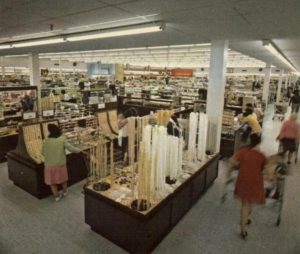
Our look at Dayton-Hudson annual reports begins with their 1969 annual report. Houston was one of the first markets out of the Midwest to receive a Target store and the first two locations, the Hedwig Village store and the South Loop store that eventually became the second Houston Auchan Hypermarket, opened in 1969. The 1969 annual report has a photo from inside one of those stores on page 30. As one can see from the photo, the store was quite a bit fancier than something like a Kmart and it was arguably even more upscale than a modern Target. Target was certainly wise to separate themselves from the competing discount store pack by offering a more upscale shopping experience. Also visible on the neighboring page is a look inside a B. Dalton.
Link to the 1969 Dayton-Hudson Annual Report
Unfortunately, Houston never did receive a Lechmere store from Dayton-Hudson even though other southern cities like Atlanta did receive their stores. Lechmeres were more or less hardline department stores that sold things like appliances, electronics, sporting goods, kitchen goods, and so forth. Lechmere was later sold to Berkshire Partners in 1989. The chain was then subsequently sold to Montgomery Ward in 1994. Unfortunately, Lechmere did not survive Montgomery Ward’s 1997 bankruptcy. Nonetheless, we can relive better times for Lechmere with page 12 of the 1970 annual report. Be sure to flip to the next page to see some scenes from a brand new Dallas Target. The page after that has scenes from inside a B. Dalton and the next page after that has an image from inside a Team Electronics store.
Link to the 1970 Dayton-Hudson Annual Report
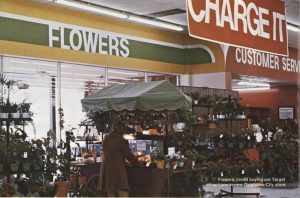
The 1972 annual report gives us some nice looks at a Target flower display at an Oklahoma City store and also a look inside a Lechmere store.
Link to the 1972 Dayton-Hudson Annual Report
The 1974 annual report shows that Target stores still had their department store flair that we saw earlier in the 1969 annual report.
Link to the 1974 Dayton-Hudson Annual Report
The 1976 annual report shows that Target was already moving towards décor that is commonly associated with 1980s Targets. The report also mentions that a fifth Houston Target, the former North Oaks Mall Target, opened in 1976. Flip over to the next page for more Target looks and another look at a B. Dalton.
Link to the 1976 Dayton-Hudson Annual Report
We now skip ahead several years to 1985 where Target discusses a new store layout to take them into the future. To keep along with a common theme, these pages also mention that a new Houston Target, the former Sugar Land Target near Williams Trace, was to open in 1986. Page 16 of the 1985 report also discusses how Houston was getting a B. Dalton Software, etc. store.
Link to the 1985 Dayton-Hudson Annual Report

The 1988 Dayton-Hudson annual report shows off what I consider to be iconic grid-like Target in-store signage. The following page, page 12, has a look inside a Mervyn’s store.
Link to the 1988 Dayton-Hudson Annual Report
The cover of the 1990 annual report truly shows what Targets would evolve into during the 1990s with the neon and familiar signage that Target used for many years. More photos of the neon décor continue on page 8.
Link to the 1990 Dayton-Hudson Annual Report
Directory of Dayton-Hudson annual reports
Egghead Discount Software
Out of all the retailers I will describe in this blog post, Egghead is probably the most obscure of the bunch. The idea of standalone stores selling PC software didn’t need to exist prior to the 1980s. By the end of the 1990s, dedicated stores selling software were fading away as discounters like Walmart and electronics big box stores like Best Buy started stocking a large amount of computer software. In modern times, many, if not most, computer users get their software through online app stores and repositories. Nonetheless, there was a brief period where dedicated software stores did serve a useful niche to the growing number of computer users.
One software store that filled that niche in Houston was Egghead Discount Software. I usually shopped at the Egghead that was an outparcel at the North Oaks Mall in Houston before the store relocated to a slightly larger location at the Albertsons/Sears Hardware/Super Crown Bookstores shopping center across Veterans Memorial from North Oaks Mall. Egghead was both cheaper and had a larger variety of software than similar competing stores such as Babbage’s and Software, Etc. that were usually located within malls. Also, Egghead was closer to me for at least a few years than the nearest CompUSA, Computer City, and MicroCenter stores. Thus, most of my software purchases in the early-to-mid 1990s were made at Egghead.
The annual reports for Egghead are not located at the Internet Archive, but rather at the University of Washington Library. Our first look at Egghead will be through their 1989 annual report. Page 7 shows an inside shot of one of their stores. As one can see, the stores were not very big, but they had demo computers where one could try out some of the latest software. Also, page 7 also shows some Egghead brand computer accessories such as floppy diskettes and printer paper that was a continuous sheet with perforations and perforated tractor feeds. Those who printed on dot-matrix and daisy wheel printers will know the joy of ripping off these portions after printing something!
Link to the 1989 Egghead Annual Report
Pages 6 through 14 of the 1991 report do a good job explaining Egghead’s operations in greater detail. Page 8 describes “The Windows Shop” that Egghead’s had within their stores to promote the sale of Microsoft Windows 3.0 and software that ran on Windows. Page 9 has an excellent image showing PC utility software for sale at Egghead.
Link to the 1991 Egghead Annual Report
Page 8 of the 1992 report shows the exterior of an Egghead store and it also has more descriptions of what Egghead had to offer. Page 9 shows a promotional display for Microsoft MS-DOS 5. It might be hard to believe that people got excited for MS-DOS, but there was often a lot of excitement when new versions of operating systems came out in the 1990s. This was especially true for Windows 95. In fact, Wal-Mart even installed banners on their stores promoting the Windows 95 launch day way back in 1995!
Link to the 1995 Egghead Annual Report
Directory of Egghead Discount Software annual reports
Federated Department Stores, The May Department Stores Company, Allied Stores (Foley’s, Macy’s, Joske’s, Venture)
This section of annual reports consists of a hodgepodge of three department store companies, Federated, May, and Allied, which operated separately for most of their existence. These chains merged at various times and now many of the department store brands exist as Macy’s. At varying times, Foley’s operated under both Federated and May ownership even before the two of them merged. Joske’s operated under Allied Stores ownership before being sold to Dillard’s.
Venture is a bit of an oddball in this mix, but they were initially started and owned by May before separating from May and becoming independent in 1990. This proceeded Venture’s ill-fated expansion into Texas.
Like a lot of other annual reports from department stores, the annual reports from these department stores really don’t show much of the stores. One interesting annual report, however, is the 1975 Allied Stores report since it has a listing of all their department stores and it also lists the size of each location. This is a great reference for those wanting to compare department stores. As big as the downtown San Antonio Joske’s felt, it was still quite a bit smaller than Seattle’s Bon Marché or Boston’s Jordan Marsh!
Link to the 1975 Allied Stores Annual Report
The 1970 May annual report does give us some looks at a very early Venture store. There’s an exterior shot on page 8 and an interior shot on page 12.
Link to the 1970 May Department Stores Annual Report
The Internet Archive only has one annual report for Venture that happened during Venture’s time in Houston. That would be the 1996 annual report and it’s in black & white. There really aren’t any photos of much worth to look at either. That said, it’s interesting to read anything about Venture during the short period of years when they were in Houston.
Link to the 1996 Venture Stores Annual Report
Interstate Department Stores (Toys R Us, White Front)
Here’s one for you Toys R Us kids…or grandparents! The Interstate Department Stores annual reports for 1968 and 1969 lets us to take a look at early Toys R Us stores. Here’s a look from the 1968 annual report.
Link to the 1968 Interstate Department Stores Annual Report
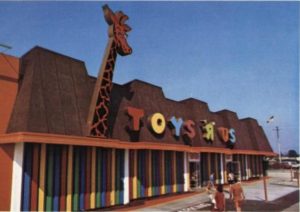
Here is a look at Toys R Us in the 1969 annual report.
Link to the 1969 Interstate Department Stores Annual Report
In 1974, the parent company for Toys R Us, Interstate Stores, which had been renamed from Interstate Department stores not long before, filed for bankruptcy and reformed the business around Toys R Us. Thus, the company took the Toys R Us Corporation name. Before we take a further look at Toys R Us, let’s take a look at a toy store for older kids that did not survive the bankruptcy, White Front.
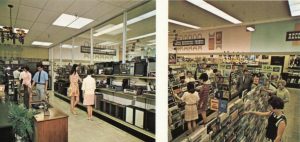
White Front was a west coast chain of discount department stores which became famous for their hard lines departments. This was especially true for electronics and appliances. In fact, the company’s name is a reference to the store displaying many appliances, which are often called ‘white goods’ within the industry, at the front of the store. Although these stores did not make it out of the west coast before going out of business, I think it’s worth taking a look at them. Information about White Front is available on page 6 of the above 1968 Interstate Department Stores annual report and page 8 of the 1969 report.
Back to Toys R Us. The 1983 Toys R Us annual report contains several photos from inside a Toys R Us store including images of their home computer display. Flip to the next page, page 10, to see 1983’s hottest toy, the Cabbage Patch Kids dolls. Pages 12-16 discuss what was a new concept for Toys R Us at the time, Kids R Us children’s clothing stores.
Link to the 1983 Toys R Us Annual Report
Directory of Interstate Department Store/Toys R Us annual reports
Kmart/Kresge
The Internet Archive has annual reports for Kresge going back to 1912. However, the first Kresge annual report we’ll take a look at is the 1961 annual report when Kresge was on the cusp of changing their history forever by launching their Kmart chain of discount stores. You might be aware that the first Kmart opened in Garden City, Michigan in 1962, but did you know there was a Kmart before the first real Kmart opened in Garden City?
Yep, Kresge opened what in what was more or less was a normal Kresge store with the Kmart name in San Fernando, California a few weeks before the Garden City in what must have been a test run of sorts.
Link to the 1961 Kresge Annual Report

Page 8 of the 1962 annual report goes into more detail and specifies that there were actually four ‘bantam’, or experimental, Kmarts along with the first batch of real Kmarts that opened in 1962 which included three Kmarts that opened in Houston that year, the Spring Branch, Baytown, and Pasadena/South Houston Kmarts.
Flipping over to page 10 of the 1962 report gives us “The K-Mart Story.” This is a detailed look at how Kresge wanted their Kmart stores to operate. It’s also interesting that Kresge used a logo that had a dash in between the ‘K’ and ‘mart’. It seems that Kresge was still experimenting with their trademarks at that point as that logo was typically used without the dash in it.
Link to the 1962 Kresge Annual Report

The dash is back in the 1963 annual report, but this time it’s used in the statement “Let’s Go K-marting!”
K-marting? Well, I wonder if Kresge was ripping off Kroger’s famous slogan or if Kroger ripped off Kresge!
Link to the 1963 Kresge Annual Report

Let’s now skip ahead to page 12 of the 1974 report. What we see here is something which discount stores do not have today, building materials departments. This has mostly been ceded to home improvement chains in modern times. Indeed, Kmart ceded their building materials departments to their own Builders Square home improvement stores years later. While it might seem strange seeing lumber and cabinets for sale at a Kmart, these are products that many homeowners want and it’s a bit surprising that modern discount stores have ignored these products. Flip this annual report back to page 6 and see some other tours of other Kmart departments as they were in 1974.
Link to the 1974 Kresge Annual Report
The 1975 annual report has many great images from inside and outside a Kmart store. These photos should bring back a lot of memories for people who were alive during this time. Be sure to flip all the way to page 10.
Link to the 1975 Kresge Annual Report
The 1976 annual report has some interesting photos as well including of the Kmart cafeteria.
Link to the 1976 Kresge Annual Report
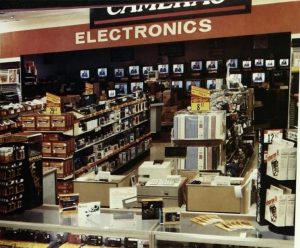
We now skip ahead all the way to 1987. By this time, fortunes were changing for Kmart. While discount store shopping had become mainstream and was eating away at established department stores, Kmart was busy spending their money on category-killer big box stores like Builders Square and Designer Depot. Wal-Mart, meanwhile, was expanding their footprint of operation and was threatening Kmart’s status as top discounter even with a smaller amount of stores. Perhaps to counter these negative developments, Kmart tried some experiments. The report describes a couple of experiments with some of Kmart’s smaller stores. One in Lima, OH, deployed what could be considered a more department store-like look. Another store in Ft. Payne, AL took a warehouse store look with items stacked high on the shelves and often they are displayed in their shipping cartons. The next page discusses how Kmart was experimenting with service desks in the electronics department to increase the amount of customer service there. They also show their electronics alcove which is a part of Kmart stores which many people have forgotten about or didn’t know about since they were walled over in the 1990s.
The department store-like look at the Lima store looks quite a bit better, in my opinion, than the typical orange stripe look that most Kmarts had in the 1980s and well into the 1990s in some cases. Perhaps Kmart would have had a better shot at turning around their fortunes if they went to that look sooner. The warehouse store look has some shades of modern retailing. Although the annual report has favorable things to say about the warehouse format, I can’t help but to think that it only would have made typical dumpy Kmarts look even more dumpy.
Link to the 1987 Kmart Annual Report
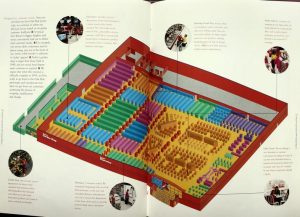
By 1991, Kmart knew they were in trouble and Kmart was trying to take steps to pull out of the malaise. One step towards this goal was to change their logo. Also, Kmart was trying to redesign their stores to make them more modern. To that extent, the 1991 annual report shows their ‘Oak Park’ layout that became common with non-Super Kmart stores built in the 1990s.
Link to the 1991 Kmart Annual Report
The 1997 annual report discusses just what the Big Kmart concept was. To many people at the time, and today, the idea of Big Kmart was just a confusing mess, but hopefully this description will try to make sense of what Kmart had in mind. Also, on page 12, Kmart discusses Super Kmarts. Those had already been around for a little while by 1997.
Link to the 1997 Kmart Annual Report
The 1999 annual report shows us one of the more interesting experiments tried by Kmart: becoming a dial-up Internet Service Provider. They weren’t just an ISP, they offered free Internet access called BlueLight.com! At a time when people were paying around $10-20 a month for dial-up service, the idea of free dial-up access was very attractive to many shoppers. Kmart even gave away free CD-ROMs at their stores that helped people get online with their service. Eventually, Kmart even sold BlueLight.com PCs. In exchange for free ISP service, Kmart would run ads on the screen as someone browsed the Internet. Kmart also surely hoped people would use their free Internet access to shop online at Kmart. While a lot of people did use the BlueLight.com free Internet service, including yours truly, it soon faded away as people started demanding broadband speeds and Kmart never truly became most people’s top Internet shopping destination. At least Kmart tried something outside of the box to try to gain e-tailing supremacy!
Link to the 1999 Kmart Annual Report
Directory of Kmart/Kresge annual reports
Kroger
Now that we have gone K-marting, it’s time to go Krogering as well! The Internet Archive has Kroger annual reports going back to 1925, but we’ll start our look at Kroger annual reports with the 1955 annual report. This was the year that Kroger entered the Houston market through their purchase of the Henke & Pillot chain of grocery stores. Henke & Pillot was a powerful player in the Houston grocery market prior to their buyout by Kroger and Kroger only slowly faded the Henke & Pillot name out from the Houston area as Kroger co-branded marketing for the store with their name and that of Henke & Pillot. Kroger has a description of the Henke & Pillot merger from the 1955 annual report. Page 10 of the 1955 annual report shows Kroger’s acquired stores, including a Houston Henke & Pillot, along with a more traditional Kroger store.
Link to the 1955 Kroger Annual Report
We now skip ahead to 1968. Page 20 of the annual report has an image of the Kroger Family Center store in Victoria, TX. Kroger Family Centers were an early attempt at combining a supermarket with a traditional Kmart-like discount store. The Pleasant Family Shopping blog did a post about Kroger Family Centers many years ago and the Houston area had Kroger Family Center stores into the 1980s at the very least. Here’s an ad for the Baytown Kroger Family Center store. This store still exists as Kroger, but it no longer has traditional discount store departments like a modern Kroger Marketplace or Fred Meyer store would have. It should also be noted that this Kroger building in Victoria is still standing. It no longer is a Kroger, but it still looks just the same on the outside as it did in 1968!
Link to the 1968 Kroger Annual Report
We don’t move too much further ahead to 1971. In this annual report, Kroger gives an excellent textual description of their new Superstores. This starts with an excellent description of Kroger’s iconic cube signs. The report continues for a few pages.
Link to the 1971 Kroger Annual Report
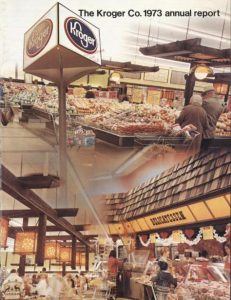
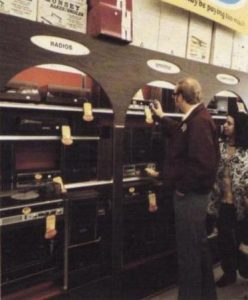
While the scan of the 1971 annual report is sadly in black and white, the 1973 is in high-quality color. We’ll start with the first page. Wow, now that is a Superstore! Keep looking and reading through the next several pages, they’re wonderful! Be sure to take a gander at page 12. On there, Kroger describes their SuperRx chain of pharmacy stores. These were sometimes located next to Kroger supermarkets, but that wasn’t always the case. In the case of stores next to a Kroger, they were often later joined with the main store itself in later years. Check out the selection of stereo Hi-Fi components at the SuperRx stores! Wow!
Link to the 1973 Kroger Annual Report
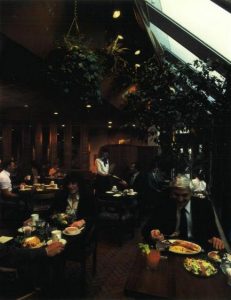
We now skip to the 1982 annual report. What’s interesting here is Kroger’s description of their experimental B.K.’s Greenhouse full-service restaurants in Atlanta and St. Louis. The B.K. must surely be a reference to Kroger’s founder, Bernard ‘Barney’ Kroger. Later Krogers did have simpler Barney’s Cafes as shown here by Retail Retell of the Mid-South Retail Blog. Of course, the Greenhouse reference is to the greenhouse architecture Kroger was using at their stores in the 1980s. It’s too bad B.K.’s Greenhouse didn’t take off. Can you imagine finding a date at the produce department of a Kroger and then taking your date for dinner at the B.K.’s Greenhouse?
Link to the 1982 Kroger Annual Report
Directory of Kroger annual reports
Melville Shoe Corporation (Thom McAn, Foxmoor, FootAction USA, Kmart Shoemart, Marshalls, Kay-Bee Toys, Circus World, Linens ‘n Things, CVS, etc.)
Believe it or not, retailers like Foxmoor, FootAction USA, Marshalls, Kmart (at least the Kmart shoe department), Kay-Bee Toys, and CVS Pharmacy all have something in common: they were all owned by a company called Melville Shoe Corporation that is now known as CVS Health. A company with as many diverse operations that operate or operated in Houston is certainly worth a look.
Our look at Melville will begin with the 1971 Melville annual report. Starting on page 6, we’ll see what was probably Melville’s most famous brand for many years, Thom McAn Shoes. Flipping to the next page will show Melville’s Meldisco division that ran Kmart’s shoe departments for many years. In fact, the photos in the annual report are of a Kmart. Page 12 gives us a look at a fairly early CVS store which had some pretty bold in-store décor! Things like that are certainly a thing of the past at modern CVS stores. The next page shows a couple of popular mall fashion stores of the time, Chess King and Foxmoor Casuals.
Link to the 1971 Melville Annual Report
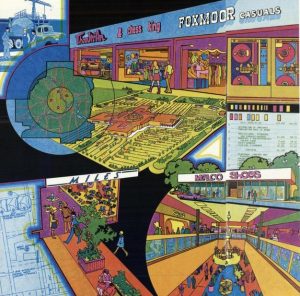

The 1972 Melville annual report is most certainly a trippy affair! Page 10 -14 show us some rather psychedelic looking retail drawings!
Link to the 1972 Melville Annual Report
We now skip ahead all the way to the 1994 Melville annual report. Pages 14-26 have some excellent panoramas of the various Melville retailers including CVS, Kmart Shoemarts, Marshalls, Kay-Bee Toys, and FootAction.
Link to the 1994 Melville Annual Report
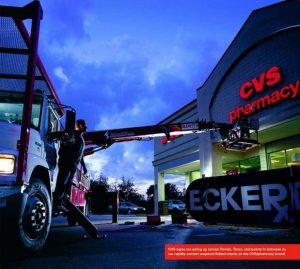
By 2004, Melville had taken the CVS name to represent their company and CVS had already started operating their own CVS stores in the Houston area. That year, CVS purchased Eckerd stores in Texas and Florida. This led to many Eckerd stores, some of which had just opened or were in the process of being built, becoming CVS stores or closing instead if they were located near another CVS location. With that in mind, here’s a photo that might make Eckerd fans cry as it shows the Eckerd logo being removed off a store and being replaced with CVS signage. I do like the text on that page about how customers will appreciate the carpeted floors that somewhat define CVS stores from that era.
Link to the 2004 CVS Annual Report
Directory of Melville Shoe Corporation/CVS annual reports
McDonald’s
There aren’t an abundance of annual reports for McDonald’s on the Internet Archive, but what is available, especially the 1960s-1980s reports, provide tremendous insights into what made McDonald’s such a powerful figure not just in fast food, but in American life in general. Each of the early reports provide so many insights that long blog posts could be developed for each report! For the sake of this post, I’ll just provide some highlights of what I thought was most interesting in these reports.
One of the points of emphasis McDonald’s made in their late 1960s-early 1970s annual reports is to discuss the importance of their architectural remodeling program. McDonald’s saw great potential in their mansard roof design and it seemed it was their goal to convert stores to that format as quickly as possible. The 1969 annual report discusses both indoor and outdoor design. In terms of the interior, page 10 discusses how licensees have options to use Mediterranean, Colonial, or Contemporary décor. The photo provides us with a great example of what must be the Colonial design. The next page shows us more interior décor and a very early mansard roof McDonald’s.
Link to the 1969 McDonald’s Annual Report
The 1970 annual report shows us another impressive looking mansard roof location.
Link to the 1970 McDonald’s Annual Report
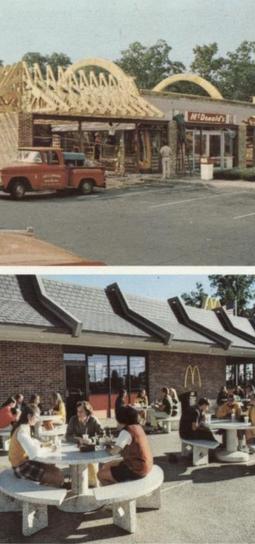
Things get really interesting on page 18 of the 1971 annual report. Here, we see a photo of a 1960s-style McDonald’s being remodeled into a mansard roof McDonald’s. About 40 years later, McDonald’s would embark on a similar campaign to renovate thousands of locations away from the mansard roof design!
Page 18 also contains some very interesting text. For one, McDonald’s discusses the idea of themed locations. Interestingly enough, many themed restaurants became much more standardized during the remodeling/rebuilding campaign that started in the late 2000s. Another interesting item on page 18 is the concept of MiniMac small-sized McDonald’s locations. These aren’t quite like McDonald’s Express locations of the early 1990s as they had full menus, but certainly the idea of downsized McDonald’s was not something new in the 1990s. Page 20 of the 1971 report discusses how McDonald’s continued testing southern fried chicken and started testing quarter-pound hamburgers. It’s probably fair to say that the quarter-pound hamburger tests were successful. The McDonald’s southern fried chicken probably wasn’t such a success though!
Pages 32-42 of the 1971 report also contains a directory of McDonald’s locations. Houstonians will probably notice that Houston is oddly missing on the list. It is true that Houston did not have McDonald’s locations yet at the time. Of course, discussion of that is beyond the scope of this article, but I know a Texas retail blogger who plans to discuss this subject in the future.
Link to the 1971 McDonald’s Annual Report
The 1972 annual report has an excellent large photo from inside a McDonald’s location on page 2. Page 10 has further discussion of new McDonald’s products. There is further discussion of the Quarter-Pounder and also the test of breakfast items, specifically the Egg McMuffin, at McDonald’s. These items were obviously a big success for McDonald’s. Also being tested in 1972 were McDonaldland cookies, which were successful, and French-fried onion rings. McDonald’s had a lot of successes with these tests, but the onion rings were not one of the successes.
Link to the 1972 McDonald’s Annual Report
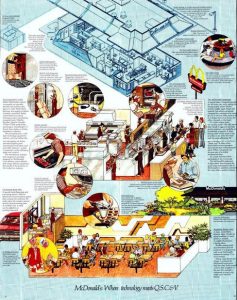
The 1981 annual report contains some interesting photos, graphics, and tidbits of information. One interesting photo is right on the cover of the report. That’s one upscale looking McDonald’s! Page 10 of the report discusses more test menu items including things called Chicken McNuggets and the McRib. Perhaps you’ve heard these items! Page 22 has an awesome diagram of a McDonald’s mansard roof restaurant.
Link to the 1981 McDonald’s Annual Report
Link to McDonald’s annual reports
Montgomery Ward
The first Montgomery Ward annual report we will look at is the 1960 Wards annual report since it has a large black and white photo of the then-new Northline Mall Wards on page 2.
Link to the 1960 Montgomery Ward Annual Report
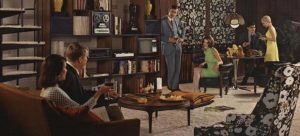
The next Montgomery Ward annual report we will look at is the 1967 annual report. This was the last annual report from Wards before their 1968 merger with packaging company Container Corporation of America that resulted in the combined company being called MARCOR.
Our look at the 1967 Wards annual report shows us something that’s a bit different from what you have been seeing with previous annual report links. Instead of looking at photos from inside stores, we will be looking at lifestyle photos showing people wearing fashions from Wards and using products from Wards at their homes and vacation destinations. These photos show life in 1967.
Pages 14 and 16 show people wearing fashions from Wards. That’s interesting itself, but the text discusses another thing from department stores of the past: charm schools. Yep, first we get a description of the Wendy Ward charm school for teenage girls that teaches the girls fashion, charm, and manners. Teenage boys aren’t left out as they could have enrolled in the ‘Man in Command’ program which teaches boys how to spend wisely and also teaches grooming, manners, and dating techniques. I’m guessing modern Walmart and Amazon shoppers don’t have access to these programs!
Page 16 shows us what home theater looked like in 1967. There’s no 70” TV here. Nope, just a small TV that’s off in the corner. What gets the spotlight in the entertainment center? The Hi-Fi, of course! Check out that reel-to-reel deck! The receiver and turntable don’t look too bad either! Oh, that shag carpet probably provides for great acoustics as well!
Page 20 shows us a kitchen that looks surprisingly modern for 1967. Okay, it doesn’t look like a modern 2021 kitchen, but it certainly seems like the kind of kitchen that maybe a NASA astronaut would have purchased from the then-new Pasadena, TX Montgomery Ward which opened in 1967! Pages 22-24 show us what Wards offers for recreation and for automotive goods.
Link to the 1967 Montgomery Ward Annual Catalog
Directory of Montgomery Ward/MARCOR annual reports
Lucky Stores (Eagle Supermarkets, Gemco, Hancock Fabrics, etc.)
Lucky Stores may not be a name that is familiar to most Houston retail enthusiasts, but Lucky operated several different retail operations in Houston and elsewhere in Texas. Lucky’s 1976 annual report informs us about four such operations. Eagle Supermarkets, a chain of discount supermarkets, is probably the Lucky division that most Houstonians remember. Eagle, along with the Magnamart Food Warehouse operation that operated in Austin and San Antonio at the very least, are mentioned on page 8 of the report.
Page 10 has photos and a description off Lucky’s memorable Gemco membership discount department store with grocery operations. The Gemco report mentions that a store opened in Texas in 1976. This is probably the 9820 Gulf Freeway location in Houston that is now a Hong Kong Food Market. Eagle and Gemco stores operated in Houston until around the mid-1980s.
Page 12 shows Hancock Fabrics, a Lucky subsidiary that was originally based in Tupelo, Mississippi that was different from Lucky’s other grocery-oriented formats. Hancock Fabrics was one of the most popular fabric stores in Houston at a time when such stores still had some popularity. The local Hancock Fabrics store to me at FM 1960 W & Jones Rd. in Houston shared a shopping center with an Eagle Supermarket that later became a Kingsaver and a Freshville Foods supermarket.
Link to the 1976 Lucky Stores Annual Report
Directory of Lucky Stores annual reports
Safeway/Safeway-era Randall’s
Out of all the retail annual reports I’ve looked at, Safeway’s reports pretty consistently have some of the best store photos and commentary about store design. Many retailers stopped including store photos in the 2000s, but Safeway continued to show off their store designs even into the 21st century.
The first Safeway annual report we’ll take a close look at is the 1969 annual report. We’ll start this tour at the cover page since it has a nice interior shot of what appears to be a Marina-style Safeway. Turning to page 4, we see a nice exterior image of a Marina-style Safeway store. The main reason for me linking the 1969 report is that 1969 was the year Safeway entered the Houston market after years of operating previously in the Dallas Metroplex. Page 12 of the report describes why Safeway wanted to enter the Houston market and it even has an image of downtown Houston which seems quite quaint compared to modern standards!
Link to the 1969 Safeway Annual Report
Safeway’s decision to enter the Houston market at least initially worked very well for Safeway. In their 1974 report, Safeway discusses how Safeway went from going from zero stores in Houston to having a whole Houston Division with 53 stores, 32 of which were built from scratch with 21 others transferred in from the Dallas Division, and a new distribution center. The report makes the claim: “Safeway has been well received in Houston.” That was true at the time, but those sentiments would not always hold true by the 1980s and certainly in the 2000s after Safeway took over Randall’s.
Link to the 1974 Safeway Annual Report

Superstores were clearly on Safeway’s mind in 1977 as a large section of the annual report for that year was dedicated to showing off the Safeway Superstore. Page 4 of the report contains an excellent panorama of a Safeway Superstore and the great variety these stores contained. Between pages 4-6, we see all the new things that these stores offered shoppers like in-store banking, a camera/photo department, cookware, gourmet foods, footwear, towels, and even electronics like TVs and microwave ovens! The funny thing is that while these stores might seem quite large, and they were large for the time, they would be considered on the smaller side compared to modern supermarkets. Nonetheless, these Safeway Superstores brought one-stop shopping to Americans who were increasingly working in addition to having their domestic duties.
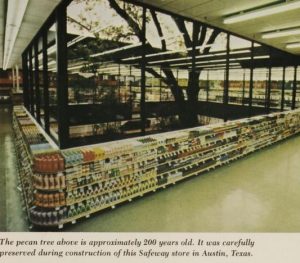
Another neat part of the 1977 report is on page 10-11 of the report. Safeway built a store in Austin which had a 200-year-old pecan tree in the center of the store that was enclosed in glass! This website has more information about the history of the Pecan Safeway, then as an AppleTree (maybe it should have been called PecanTree?), and finally as a Randall’s. Of course, this store became a Safeway store again when Safeway acquired Randall’s, but the pecan tree rotted during the early Randall’s years and had to be removed. Unfortunately, the Randall’s closed recently and it seems HEB has a lease for the property now.
Link to the 1977 Safeway Annual Report
We now skip ahead to the 2004 Safeway annual report. The theme for 2004 was Safeway’s Lifestyle themed stores which, of course, made their way into many Randall’s stores. Most Houston Randall’s stores that are still around here in 2021 still have one of the Lifestyle décor variants. Page 10 has a full spread showing the Lifestyle décor, but images of the Lifestyle décor are on pages 8-14. In fact, that last page specifically talks about the Lifestyle package’s warm look with earthtones and custom flooring. I know I am personally a fan of the Lifestyle look and I think it is aging well especially compared to the industrial, grayscale designs used by many grocery chains here in current times.
Link to the 2004 Safeway Annual Report
Directory of Safeway annual reports
Sears, Roebuck, & Company
While Safeway may have some of the best annual reports throughout their history, Sears annual reports are a bit of the opposite story. Sears, like a lot of department stores, didn’t show too many photos of their stores in their annual reports. They’re not as bad as JCPenney about this, but it can take quite a bit of work to find Sears reports which have a lot that is visually interesting. That said, the 1956 Sears annual report does have several interesting tidbits in it that we will look at here.
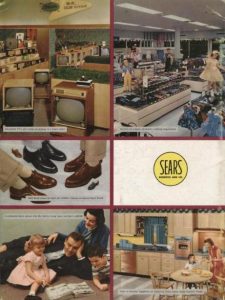
The interesting bits start at the very beginning of the report. The cover has three images of colorful home and clothing fashions that were being sold by Sears at the time. The fourth image on the cover is certainly less colorful since it’s of a car tire and battery, but this is an example of Sears using the Allstate name on automotive parts, and sometimes even on whole cars being sold by Sears, before the Allstate name became solely known for Sears’ insurance division. The following page has more interesting images from inside a Sears store showing some of the core hardlines departments.
Page 20 of the 1956 report discusses the opening of new Sears stores from that year and how Sears distinguished between bigger and smaller stores. As we can see from the text, the original Pasadena Sears opened in 1956. This was the store that relocated to Pasadena Town Square/Plaza Paseo/Macroplaza Mall in the 1990s where it became the last full-line Sears store to be constructed in the Houston area. The Pasadena Town Square Sears also became the last Houston area Sears store to operate in the Houston area, but it too closed in 2020. This video by Je of the Louisiana & Texas Retail Blogspot shows the Pasadena Town Square Sears’ final minutes before closing forever.
Page 34 of the 1956 report discusses some of Sears’ suppliers for their house brands. Whirlpool appliances are discussed in the narrative. Whirlpool became known for being a supplier of Sears Kenmore and Coldspot appliances for many decades. Page 36 discusses how Sears sourced their televisions. Page 38 then has a listing of Sears house brands at the time. Some of these names, like Kenmore and Craftsman, will surely be known to Americans today, but other brands have long since been discontinued. As previously mentioned about Allstate automotive parts, Sears sometimes reused their brand names for other purposes. The Homart name was used in 1956 on plumbing, heating, and building materials, but the Sears Homart division became one of the most significant retail developers in the nation which included Homart developing the Baybrook, Willowbrook, and Deerbrook Malls in Houston along with co-developing The Woodlands Mall.
Finally, the last page in the 1956 report shows more color photos of products that were being sold by Sears at the time.
Link to the 1956 Sears Annual Report
We now skip ahead all the way to the 1997 Sears annual report. In the 1997 report, Sears discusses many of their retail operations aside from their full-line stores. Page 12 discusses their Sears Hardware stores, which were numerous in Houston during the 1990s-2000s, NTW/NTB automotive service centers which still exist in Houston even if they are no longer owned by Sears, and also Sears discusses how the once-famed retailer Western Auto, which was owned by Sears at the time, was essentially being phased out.
The following page discusses Sears HomeLife furniture stores. In the 1990s, Sears had started to move furniture out of their full-line stores and into standalone furniture stores called Sears HomeLife that looked like what one would expect from a regular furniture chain. I know that I went to the Sears HomeLife store on I-45 and Richey Rd., where the Bel Furniture is now, several times in the 1990s. Also discussed is the opening of Sears’ The Great Indoors stores. The Great Indoors sold higher-end home fashions, fixtures, flooring, appliances, and even electronics in their earliest days in Houston with their stores near Memorial City and Willowbrook Malls. I shopped at the Willowbrook area location, which is now At Home, several times and it was the first place I saw a demonstration of a D-VHS VCR. These were digital VHS VCRs which could playback and record high-definition video a few years before Blu-Ray discs came out in addition to playing and recording regular analog VHS tapes.
Link to the 1997 Sears Annual Report
Directory of Sears, Roebuck, & Co. annual reports
Southland Corporation (7-Eleven/Chief Auto Parts)
7-Eleven convenience stores are probably known to most people, but they probably aren’t the first chain of C-stores that come to mind for most Houstonians given that they entered this market, left, and is now starting to return once again. Given 7-Eleven’s return to Houston, it might be worth taking a look at 7-Elevens past to become re-acquainted to them. This look at 7-Eleven comes to us from the 1984 Southland Corporation annual report. Southland Corporation was the parent company for 7-Eleven at the time. Southland also owned the Chief Auto Parts chain that were often joined to 7-Eleven locations as one can see on page 10 of the report. Pages 10-20 have several different looks at 7-Eleven and Chief stores.
Link to the 1984 Southland Corporation Annual Report
The 1985 annual report gives us a look at another venture C-stores used to be involved in: video rentals. Yep, one could rent movies from Houston 7-Eleven and Circle K C-stores in the 1980s! Retailers were eager to get involved in video rentals since not only would someone have to visit a store to rent a movie, but they would also have to make another visit to the store to return the video. This helped tie customers to the chain and it also surely helped drive impulse buys.
Link to the 1985 Southland Corporation Annual Report
Directory of Southland Corporation annual reports
Tandy Corporation (Radio Shack, VideoConcepts, McDuff, Computer City, Incredible Universe)
Tandy’s annual reports are not currently available on the Internet Archive, but fortunately we can still take a look at annual reports from the former electronics retail giant. There is a website called RadioShack Catalogs which has nearly every annual Radio Shack ever produced scanned and available freely to view on their website. In addition to the catalogs, they have other Radio Shack documents scanned on their website as well. These include some Tandy annual reports.
The first Tandy annual report we will look at is their 1977 annual report. Page 8 of the annual report has an excellent breakdown of sales forecasts by product type. From this, we can see that CB accessories (but not radios), Hi-Fi audio, calculators, and video games were expected to be hot sellers in 1977. The annual report breaks down all these product categories and goes into fairly high detail about the hottest trends. For example, Tandy discusses changes in the marketplace favoring single record turntables, such as the Realistic LAB-400 direct drive turntable shown on page 10, over record changers, higher wattage amplifiers, and Radio Shack’s decision to sell some stereo separate components even if they recommend receivers over separates. This type of discussion will certainly interest electronics enthusiasts! Pages 56-60 shows the performance of Tandy as compared to other major retailers such as Kmart, Eckerd, and Melville.
Link to the 1977 Tandy Annual Report
Page 14 of the 1979 Tandy annual report also gives a very detailed industry report which discusses trends in the electronics retailing industry. As someone interested in these items, I can tell you that many of Tandy’s predictions proved to be spot-on. For example, Tandy predicted in this annual report that Hi-Fi was ‘over-stored’ since so many people were selling Hi-Fi at the time and that would eventually lead to a drop-off in sales. That’s exactly what happened.
Link to the 1979 Tandy Annual Report
The 1984 annual report continues the assessments of the consumer electronics industry. Of course, since we’re now into the 1980s, some new technologies are hot such as CD players and cellular telephones. This analysis starts on page 6 of the 1984 report.
Link to the 1984 Tandy Annual Report
In 1985, Tandy acquired two electronics store chains in their growing effort to sell a variety of brands of electronics in varying store formats. VideoConcepts, acquired from Eckerd, allowed Tandy to sell brand-name electronics in a mostly mall-focused format. The McDuff acquisition allowed Tandy to sell appliances along with electronics and to do so in superstore, big box settings along with malls. These goals are all discussed on page 12 of the 1985 report.
Link to the 1985 Tandy Annual Report
Unfortunately, there is a gap in the annual reports on the RadioShack Catalogs website between 1985 and 1994. Thus, we don’t get to see what happened to McDuff and VideoConcepts stores, but fortunately other websites can help us with that evaluation. The good news is that the 1994 annual report will help us look at two concepts Tandy was optimistic about in the 1990s, Incredible Universe and Computer City. Incredible Universe were electronics ‘gigastores’ that are described on page 10 of the 1994 report and page 4 has a large panorama from inside an Incredible Universe. Computer City was a concept similar to CompUSA stores and are described on page 8 of the 1994 report. Although Computer City lasted longer than Incredible Universe, I did shop at both stores in Houston and have fond memories of both.
Link to the 1994 Tandy Annual Report
Directory of Tandy Corporation annual reports
Walgreens/Globe Discount City
Our first look at Walgreens annual report will start with their 1952 annual report. This report has an excellent large photo of the Walgreens that used to be at 822 Main in downtown Houston. The text describes how the store on Main was a combination self-service and conventional location.
Link to the 1952 Walgreens Annual Report
Page 14 of the 1962 Walgreens annual report shows how big Houston was to Walgreens at the time. Aside from Walgreens’ hometown of Chicago and nearby Milwaukee, no city had more Walgreens locations than Houston. That’s not even counting the Globe and Danburg stores. Houston was clearly a big market for Walgreens and that remains true today with Walgreens using Houston as a test for their Village Medical concept. Also, make note of Walgreens listing Sanborns locations in Mexico as part of their stores. Walgreens was a major investor in Sanborns for many years. Sanborns is still a major Mexican department store chain and they also operate Sears Mexico stores which are much healthier than US Sears stores.
Link to the 1962 Walgreens Annual Report
Just about every Walgreens annual report for a handful of years after 1962 has some kind of photo of a Globe store and also news about Globe stores. That’s worth checking out for any Globe fans. Here’s a look inside a Globe store from the 1966 annual report. Also, check out the news from that year about Walgreens building a new distribution center in Houston.
Link to the 1966 Walgreens Annual Report
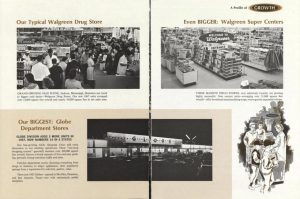
The 1967 annual report shows Walgreens’ three tiers of retail stores with their normal stores which have 15,000 square feet overall, their bigger stores Walgreens Super Center stores which have over 31,000 square feet of space, and the Globe stores which have over 100,000 square feet overall.
Link to the 1967 Walgreens Annual Report
The 1968 annual report not only has more information about the retail store concepts used by Walgreens, but the following pages even have information about Walgreens’ restaurants including Walgreen Grill Rooms, Corky’s fast food, and the Robin Hood sit-down restaurant.
Link to the 1968 Walgreens Annual Report
The 1973 annual report has a nice panorama image of a Globe.
Link to the 1973 Walgreens Annual Report
The 1974 annual report discusses a new neighborhood-style smaller Globe store which opened in Houston. Also, check out that “Walgreens – A Great Place to Dine” headline above the Globe story!
Link to the 1974 Walgreens Annual Report
Directory of Walgreens annual reports
Walmart
It is probably an understatement to say that Walmart was a master at salesmanship in their early years under the leadership of Sam Walton. Those salesmanship skills allowed them to grow from being a small discount store chain focused on small cities in and around Arkansas into the international retail powerhouse that they have been for the last few decades. It is perhaps not surprising that Walmart’s early annual reports also do a masterful job selling the companies to investors. Walmart’s 1970s and 1980s annual reports are full of excellent store photos and text that describe the growth of the chain and their future goals.
There’s so much to look at in the Walmart annual reports of the 1970s and 1980s that I’m just going to quickly mention several reports without offering much commentary just to keep things moving. It probably goes without saying that it’s worth flipping through all the pages of these annual reports even if I only specifically mention certain pages.
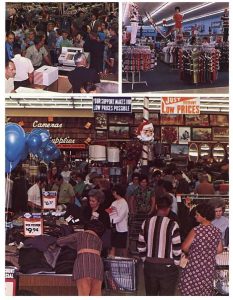
Our first look at Walmart annual reports will be the 1972 report. Pages 2 and 10 provide some looks into a Walmart store when the chain was only about a decade old.
Link to the 1972 Walmart Annual Report

Page 6 of the 1973 annual report offers some more photos of an early 1970s Walmart store.
Link to the 1973 Walmart Annual Report
Page 6 of the 1978 annual report not only offers some excellent photos of the outside of then-new Walmart stores with their prominent Sports Center and Discount City signage, but the text also provides a brief overview of Walmart’s history to that point and it also explains the nature of Walmart stores and locations at that time.
Link to the 1978 Walmart Annual Report
Pages 8 through 14 of the 1979 annual report have some interesting photos of Walmart stores. As we can see, the Sports Center and Discount City signage has changed somewhat since the 1978 report. Also note that in 1979, Walmart was rolling out what it called their first “Super Store” in Springdale, AR. The store gained 23,000 square feet in space and added an automotive service center and a pharmacy. Page 14 shows an early example of a Walmart gas station.
Link to the 1979 Walmart Annual Report
Page 12 of the 1980 annual report discusses the ‘Project ‘79’ experimental store in Pine Bluff, AR. This store shows some of the features that came to define 1980s Wal-Marts such as the brown façade and brownish orange interior décor. Page 14 has more interesting Walmart images including ‘Wal-Mart Energy Express’ vans that were used to transport employees to the store during a time when gasoline supplies were short and fuel prices were high.
Link to the 1980 Walmart Annual Report
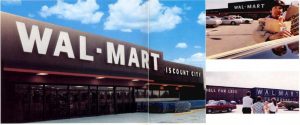
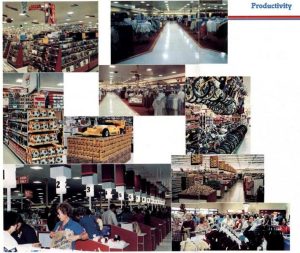
Page 6 of the 1981 annual report shows us various facades of Wal-Mart stores at the time with the large one on the left being the one most people are familiar with. Page 8 has many great interior shots from a Walmart store of the time including the checkout pylons, the large selection of music albums, sporting goods, and a Pennzoil display featuring the famed Chaparral 2K Pennzoil-sponsored Indycar that won the 1980 Indianapolis 500 with Texan Johnny Rutherford behind the wheel. Pages 10-12 show more various Walmart photos showing orange carpeting and western design lettering.
Link to the 1981 Walmart Annual Report
The Walmart images shown on pages 6-8 of the 1982 Walmart annual report will look very familiar to those who shopped at early Houston-area Walmart stores. That particular design of Wal-Mart Discount City stores had matured and was being used to fuel Walmart’s growth in the 1980s. Page 10 discusses Walmart’s integration of the Kuhn’s-Big K stores that Walmart had acquired. These Big K stores are not to be confused with the unrelated 1990s Big Kmart stores or the Kroger store brand colas. Mike from the Houston Historic Retail blog recently covered these converted Big K stores.
Link to the 1982 Walmart Annual Report
The 1983 annual report has a few interesting looks at Walmart stores. In addition to low prices, Walmart did carry some brands like Pioneer in their electronics departments that were a cut above the usual electronics fare at discount stores. This is visible on page 10 of the annual report. This surely helped drive traffic to their stores from shoppers who ordinarily would have steered passed a discount store. I know that we purchased a Pioneer turntable, which I still have, from a 1980s Walmart. At the time we purchased that turntable, Walmart had put their electronics in a small semi-enclosed cube in the center of the store.
Link to the 1983 Walmart Annual Report
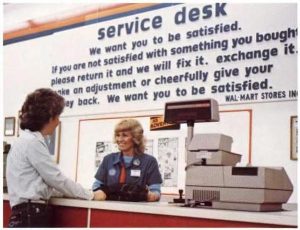
The 1984 annual report also has some interesting looks at Walmart stores. I quite vividly remember the satisfaction guaranteed statement that Walmart would put up at their service desk. For those who were not around to see it in-person, there is a photo of it on page 10.
Link to the 1984 Walmart Annual Report
As we progress into the late 1980s, we start to see some experiments Walmart was trying with larger format stores including the now-familiar Walmart Supercenter. In addition to the Supercenters, Walmart also tried a hypermarket format called Hypermart USA that was similar to what we had in Houston with Auchan. We get to look at a Hypermart USA on page 8 of the 1988 annual report.
Link to the 1988 Walmart Annual Report
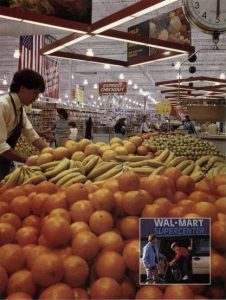
Page 10 of the 1989 annual report gives us a glimpse inside an early Wal-Mart Supercenter. While Walmart Supercenters seem so common today, I personally did not shop at one until the late 1990s so it’s quite interesting to see what the Supercenter format looked like when it was first introduced.
Link to the 1989 Walmart Annual Report
Directory of Walmart annual reports
Wendy’s
The Internet Archive only has one scanned Wendy’s annual report, the 1974 one, but I believe it’s worth linking here since there are some excellent photographs in the report.
Link to the 1974 Wendy’s Annual Report
Woolworth/Woolco
Our first look within Woolworth annual reports will the 1950 annual report. This this report, Woolworth provided some excellent color photos showing the interior of a Woolworth store. This is an excellent look at what a discount/variety store would have looked like in the mid-20th century.
Link to the 1950 Woolworth Annual Report

The 1961 Woolworth annual report discusses what Woolworth has planned for their entrance into the large discount store game with their Woolco stores that ended up being prominent in the Houston area during the 1960s through the very early 1980s.
Link to the 1961 Woolworth Annual Report
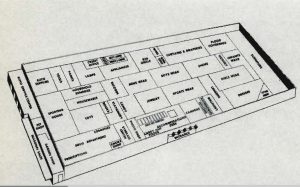
The 1962 annual report has an excellent store layout diagram on page 22 which shows all the departments a Woolco store would have had in their earliest days and where those departments were located in the store. Page 20 of the same annual report has a color photo of the exterior of an early Woolco store.
Link to the 1962 Woolworth Annual Report
Pages 8-20 of the 1964 Woolworth annual report has some excellent color photos of regular Woolworth stores, Woolco stores, and also of Woolworth’s Kinney Shoes division that operated out of many Houston shopping centers and malls. Page 12 has a photo of the downtown Houston Woolworth store.
Link to the 1964 Woolworth Annual Report
Several of the 1960s Woolworth annual reports have what are called the Woolco “Directory of Progress.” These are listings of Woolco locations and what year those stores opened. This is an excellent resource for retail enthusiasts. Here is the Woolco Directory of Progress in the 1969 annual report. Some excellent photos of a Woolco store exist on the previous page.
Link to the 1969 Woolworth Annual Report
Page 8 of the 1970 Woolworth annual report has some excellent photos showing Woolworth’s dining options as they were at the time. The photo of the Woolworth Restaurant at the bottom right hand corner of the page looks quite similar to what the Woolworth Restaurant looked like at Almeda and Northwest Malls in Houston.
Link to the 1970 Woolworth Annual Report
Woolworth was celebrating their 100th anniversary in 1979. As a result, the annual report is longer than most as it contains an article with illustrations about Woolworth’s history. This is worth reading for anyone who wants to know more about Woolworth’s history up to that point. After the historical piece, the report has some excellent photos inside Woolworth and Woolco stores of the time.
Link to the 1979 Woolworth Annual Report
By 1989, a lot had changed with Woolworth. Woolco no longer existed, at least not in the United States, and Woolworth’s operations in the US were increasingly becoming centered on their mall shoe stores such as Foot Locker, Kinney, and Champs Sports. In fact, it is modern Foot Lockers which carry on the legacy of the Woolworth chain. The 1989 annual report contains detailed drawings on pages 6-16 of all their store entrances, mostly mall entrances, of all of the various retailers Woolworth was operating at the time. This is quite neat and it contains a drawing of the Woolworth Express concept which was the last traditional variety Woolworth store that I ever shopped at when they briefly had a location in the Sears wing at Willowbrook Mall in Houston in the late 1980s/early 1990s.
Link to the 1989 Woolworth Annual Report
Directory of Woolworth annual reports
Yum! Brands (Pizza Hut, Taco Bell, Kentucky Fried Chicken, etc.)
The history of Yum! Brands and their core brands is rather convoluted. The simplest way to describe the situation is to say that Pizza Hut, Taco Bell, and Kentucky Fried Chicken all started as independent companies that were acquired by PepsiCo in the 1970s and 1980s. PepsiCo subsequently spun off their fast food operations as Tricon Global Restaurants in 1997. In 2002, Tricon and Yorkshire Global Restaurants merged to form Yum! Brands.
The Internet Archive has annual reports for PepsiCo, Tricon, and Yum! Brands. In addition to that, the Internet Archive also has annual reports for various ownership groups that owned Pizza Hut and Kentucky Fried Chicken before they were acquired by PepsiCo. We’ll now take a look at the 1970 Pizza Hut annual report which shows that Pizza Hut had brand diversity not too dissimilar to what Yum! has in modern times. Page 8 of the 1970 Pizza Hut annual report shows a typical Pizza Hut sit-down location in an era before their roofs were painted red. The next page discusses Pizza Hut’s Next Door restaurant concept which served hamburgers and other dishes popular at American restaurants. Page 12 shows us Pizza Hut’s Flaming Steer steakhouse concept. Finally, page 16 shows that Pizza Hut was married to a taco restaurant even before Taco Bell came along. In this case, Pizza Hut owned the Taco Kid chain that was formed with the acquisitions of the Taco Kid and Taco Boy chains. I dare to say that for most people, all these brands except for Pizza Hut itself are long-forgotten!
Link to the 1970 Pizza Hut Annual Report
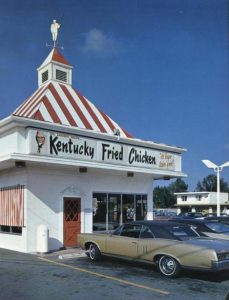
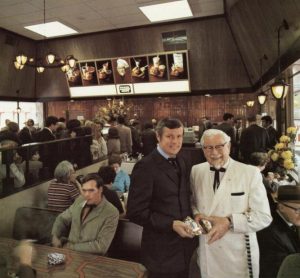
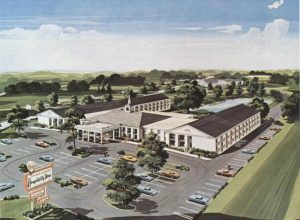
The 1969 Kentucky Fried Chicken annual report shows that KFC was hardly relying on just the success of the KFC restaurants as they were trying many mostly forgotten concepts as well. Pages 6-18 of the 1969 KFC report discusses and shows many detailed photos of concepts they were trying at the time including Kentucky Roast Beef, H. Salt, esq., English Fish & Chips, and the Colonel Sanders Inns. Yep, KFC ran a motel chain and we briefly had a location in Houston as explained by the Carbon-izer page!
Link to the 1969 Kentucky Fried Chicken Annual Report
Just to show that Taco Bell isn’t being ignored in this entry, here’s an image of a 1970s Taco Bell using Spanish mission architecture in the 1979 PepsiCo annual report. The previous page has an image inside a Pizza Hut sit-down restaurant.
Link to the 1979 PepsiCo Annual Report
Link to Pizza Hut annual reports
Link to Kentucky Fried Chicken annual reports
Link to PepsiCo/Tricon/Yum! Brands annual reports
Other Retail Annual Reports
American Stores, Acme Markets, & Skaggs
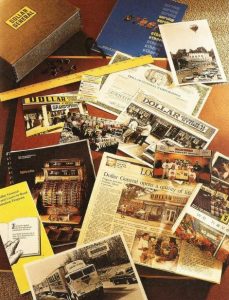
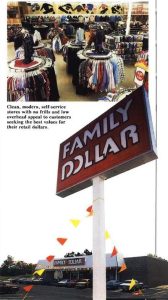
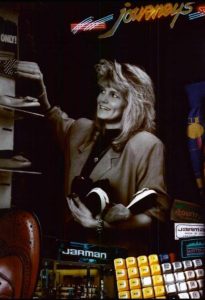

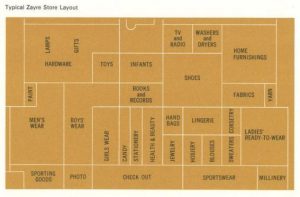
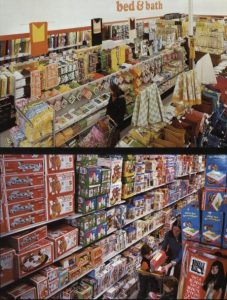
I hope you have enjoyed this look at retail history contained within annual reports. As mentioned at the beginning of this post, this is just a sampling of what is available in the linked annual reports. There is sure to be a considerable amount of interesting things left for you to discover by browsing these annual reports. If you find anything interesting, please feel free to mention it in the comments! Also, if you find any other retail annual reports that are available on the Internet, please feel free to share them with us in the comments section.




Walmart passed Kmart long before 1984. If you use the reports and compare discount operations to discount operations, Walmart was already ahead in 1984, even though Kmart had higher total sales (including their subsidiaries).
Really too bad that the McDonald’s annual reports is missing the 1985 annual report, where, according to Ray Kroc’s autobiography (a section added posthumously), they posit a McDonald’s may be on a space station “in a decade or two from now”.
GREAT POST!!! I HAVE LOTS OF MEMORIES OF THESE STORES. WASN’T AWARE THAT LECHMERE WENT SO FAR SOUTH.
Hi Anonymous, I’m glad you liked the post. Lechmere didn’t last very long in the south, unfortunately. I wish they came to Houston, their stores look like they were pretty awesome and their product mix had exactly the kind of stuff that I find to be neat. I would have spent a lot of time there!
Thanks, Retail Retell! It must have slipped my mind because I forgot that you are a retail enthusiast with an accounting background! Well, if you do find anything interesting in the financial parts of these reports, do let us know! All I know is that when a company says they are “biting the bullet,” as Kmart said on page 4 of their 1995 annual report in regards to their finances, it’s probably not a good sign about their financial status, lol.
I’m sure you’ll enjoy going through these annual reports. What I wrote in my blog post only scratches the surface of what’s available in these annual reports. There really is a lot of interesting stuff to explore, but obviously that will take a long time and so that’s why I recommended that people take their time exploring these because there are certainly interesting things you’ll find in these which will lead to a lot of Wikipedia, Google, etc. searching, lol.
I echo the above comment, this is a very impressive post! It’s going to take me a while to get through all of this, but I will at least comment now that technically I am a “retail enthusiast with an accounting background” 😛 Even so, the pictures and information are still much more interesting than the financial statements XD
Whoops, the reply I made at May 13, 2021 at 12:39 am should have been in reply to your comment. I guess I must have clicked on the wrong comment button! Oh well, I do want to add that I didn’t realize that Hancock Fabrics was originally from Tupelo, MS! That’s certainly something that I learned from reading the Lucky Stores annual reports. I suppose they started out in your part of the world!
Excellent read. I HATE Wally World and wish they would disappear. I loved Kroger Family Centers and the Square cube sign.
I also preferred Old school Target
Gemco was cool.
Liked Eagle Supermarket also
Hi Margaret, I’m glad you liked the post. The good news is that although they are pretty rare these days, there are still some Houston-area Kroger stores which still have the cube signs. Two that come to mind to me immediately are the Woodforest Blvd. Kroger in East Houston and also the Seabrook Kroger. Here is a link to a Google Streetview image of the Woodforest Blvd. Kroger: https://goo.gl/maps/EgnVvXrJCpKT8Mc69
Carbon-izer has some photos of the Seabrook Kroger cube on their page: http://www.carbon-izer.com/retail/kroger/seabrook.html
Kroger Family Center stores were indeed a great attempt at one-stop shopping. They felt more comfortable and less-warehouse like than something like a Walmart Supercenter or a modern Kroger Marketplace store. It’s too bad the Kroger Family Center stores didn’t work out, but I suppose we had them for longer here in Houston than most other places. The Brazos Buildings & Businesses blog did an interesting post about the Kroger Family Center in Bryan, TX that you might be interested in: https://csroadsandretail.blogspot.com/2012/12/kroger-all-in-family-center.html
I also prefer the older Targets to the modern ones even if Target has maintained their stores better than most other retailers. That photo from one of the Houston Targets in 1969 really shows some higher-end, department store-like features. The ‘graph paper’ signage at the 1980s Targets are really memorable as well.
One neat thing about Eagle is that a lot of former Eagle locations still have the same shape signs that Eagle had way back in the day. For example, here is one at an ex-Eagle that is now a Food Town on Little York Road: https://goo.gl/maps/AUFpsUFyFsjS6ZJG8
Mighty impressive!